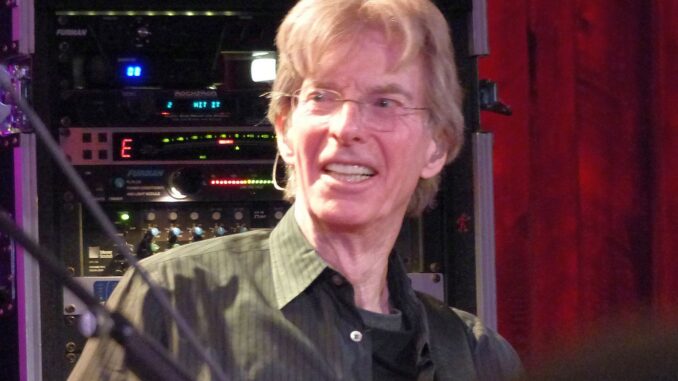
Phil Lesh has left The Phil Zone
The Grateful Dead are one of the most musically and culturally influential bands of the 20th Century, and Phil Lesh, who died at home surrounded by his family on the 25th October at home, brought significant musical innovations to the Dead’s sound and attitude throughout their career. The unlikely friendship of this trumpet-playing avant-garde classical music student and free jazz fan and bluegrass banjo player Jerry Garcia led to the formation of the Grateful Dead and the beginning of a long strange trip.
Phil Lesh was born on 15th March 1940, in Berkeley, California, and while he was musical from an early age, he struggled with the restrictions that a formal musical education imposed. At the time he joined the other Grateful Dead founding members in the Warlocks Phil Lesh couldn’t play bass, but as the Warlocks became the Grateful Dead he put himself at the centre of the developments around the use and sound of the bass in rock music. In his hands, the bass became much more than a basic rhythm instrument, taking on the characteristics of a lead instrument as the improvisations and songs demanded.
The Grateful Dead are the most representative San Francisco band, a band that managed to keep the original ideals more or less alive throughout their career and the band that best provided a musical soundtrack to the psychedelic experience. It was Phil Lesh who was able to help his other band members find a way of capturing musically the psychedelic experience. The band’s second album, “Anthem of the Sun”, used the studio to craft a sound that mixed life and studio tracks on the same song, and band members played a range of instruments. Phil Lesh’s friend Tom Constanten joined the band in the studio which upped the influence of composers like John Cage and Karlheinz Stockhausen. As contemporary reviews noted at the time, “Anthem of the Sun” and its cover dripped acid, and it was Phil Lesh and Jerry Garcia who drove this sound.
While Phil Lesh along with Jerry Garcia was a key architect of the Grateful Dead’s sound, he contributed comparatively few actual songs to the band’s repertoire, but ‘New Potato Caboose’, ‘Box of Rain’ which was for Lesh’s then dying father, ‘Unbroken Chain’ which is a signature Grateful Dead song, ‘Pride of Cucamonga’ which featured piano and John McFee’s pedal steel guitar and wasn’t performed live in Jerry Garcia’s lifetime but it has featured strongly in the repertoire of the various incarnations of post-Grateful Dead members, and ‘Passenger’ from “Terrapin Station” all have their place in the pantheon of Grateful Dead songs. In the early days of the Grateful Dead he provided high harmonies to the band’s vocal mix, and very occasionally sang lead vocals as he did on ‘Box of Rain’. When Donna Jean Godchaux joined the band his vocal contributions diminished due in part to vocal chord issues he was experiencing, and he stopped singing in 1973 and it wasn’t until 1985 that his voice, now a baritone, was heard again. Phil Lesh was also key to Ned Lagin’s electronic composition “Seastones” being recorded with the help of the Grateful Dead and released on their Round label. While many deadheads may have scratched their heads at the heavily process sound of bleeps and burps, it is now recognised as a significant recording in the development of electronic music.
When the Grateful Dead disbanded following the death of Jerry Garcia in 1995, Phil Lesh toured with various combinations of ex-Grateful Dead members in The Other Ones, The Dead and Further which kept the Grateful Dead’s songbook alive. He also toured with his band Phil Lesh and Friends who released a studio album of Phil Lesh songs written with Robert Hunter and members of the Friends. In 2012 he opened Terrapin Crossroads, a music venue that gave a permanent home to Phil Lesh and Friends and featured his sons Grahame and Brian as members of the house band. With his wife Jill, Phil Lesh founded the charitable Unbroken Chain Foundation, and was the first Grateful Dead member to capture his experiences in print with 2005’s “Searching for the Sound: My Life with The Grateful Dead”.
It is very hard to truly do justice to Phil Lesh’s achievements because he could see and hear things most other people couldn’t. He helped define how his chosen instrument could be played, and as such joins that handful of legendary musicians including Paul McCartney, Jack Cassidy, Motown’s James Jamerson, and Jack Bruce. He also brought the sounds of avant-garde classical music and free jazz to an unbelievably large audience, even though listeners may not necessarily have understood where the ideas were coming from. The Grateful Dead’s army of fans collectively known as Deadheads, and a social phenomenon in their own right, saw Phil Lesh as their standard bearer within the core of the band, another example of his importance to the whole Grateful Dead experience. Finally, Phil Lesh was a great family man whose wife Jill was his financial manager and business partner, and whose sons Grahame and Brian followed him into the music business, and that’s where our thoughts should be directed at this time.



Sad to see another great gone. This is the first mention I’ve seen of this news. Sad comment on today’s culture.
Sad indeed. A very talented good human.
RIP